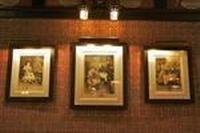Presented to the Club by Elbert Scranton Platt, Non-Resident member from Troy. Mr. Platt was proposed for membership in 1917 by John Treadwell Norton, Club President 1904-1906.
On display in the Newspaper Room, the sword is of the Tachi type, meaning it is worn with the cutting edge facing down rather than up like a Ratana. The blade construction is attributable to Yamato Tegai (approx. 14th Century) and the fittings are from the late Edo period (approx. early 19th Century). Yamato is the Province in Japan where Tegai School made blades.
THE STORY BEHIND THE LINCOLN VOLK MASK
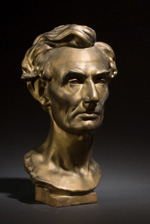
Donated by William J. Cromie, MD, Club President 11/13-11/15. Given at his last Board of Trustees Meeting November 2015.
Sculptor Leonard Volk first met Abraham Lincoln in 1858 when Lincoln was debating Steven Douglass for the US Senate seat from Illinois. Douglass was Volk's brother in law as well as a patron and introduced him to Lincoln. During that first meeting, Volk, with the eye of an artist, could see the character in Lincoln's face and asked him to sit for a bust. Although Lincoln good-naturedly agreed, it took two more years of insistence and perseverance by Volk to finally get Lincoln to sit. Eventually in March 1860, shortly before Lincoln received the Republican nomination for president, Lincoln fulfilled his promise to Volk.
The intention of the sitting was to sculpt a portrait bust and to this end, Lincoln made several trips to Volk's 5th floor Chicago studio. On the first visit, Volk took some measurements and made a mask so that he could continue to work on the bust between sittings. Volk used a poorly prepared thick plaster applied directly to Lincoln's face. Volk described the unfortunate results." It was about an hour before the mold was ready to be removed, and being all in one piece, with both ears perfectly taken, it clung hard, as the cheek-bones were higher than the jaw at the lobe of the ear. He bent his head low and took hold of the mold, and gradually worked it off without breaking or injury; it hurt a little, as a few hairs of the tender temples pulled out with the plaster and made the eyes water." Lincoln who endured the ordeal in typical stoic humor later said that the process "was anything but agreeable."
Despite the painful first sitting, Lincoln enjoyed the sessions as an opportunity to escape the hectic campaign. Volk reported that "He would talk unceasingly telling the funniest and most laughable of stories, but he talked little of politics or religion during those sittings." Lincoln was quoted as confiding "I am bored nearly every time I sit down to a public dining table by someone pitching into me on politics."
The bust progressed quickly and Lincoln was impressed with Volk's effort. After a few sittings Lincoln looked at the bust and proclaimed "There is the animal himself." This was a compliment that Volk would cherish for his entire life. For the next weeks Volk continued to work on the bust and even sculpted a small cabinet sized replica. On May 18th, the day Lincoln received word of his nomination, Volk appeared at Lincoln's Springfield house with the completed cabinet bust as a present for Mrs. Lincoln. Lincoln was alone but happy and excited and greeted Volk warmly. They shook hands and Volk said, "I am the first man from Chicago, I believe, who has the honor of congratulating you on your nomination for President."
Volk would create many fine Lincoln sculptures during his career, but he will be most remembered and appreciated by history for his remarkable mask of Lincoln captured at an historic moment. Through the years, almost every artist and painter attempting to capture Lincoln's elusive image has referenced Volk's mask. Lincoln's secretary John Hay later said of the Volk mask, "the face has a clean firm outline; it is free from fat, but the muscles are hard and full.; the large mobile mouth is ready to speak, to shout, or laugh; the bold curved nose is broad and substantial, with spreading nostrils; it is a face full of life, of energy, of vivid aspiration." It is indeed the face of the man who captured the country's favor and became our 16th president.
This sits on the mantle across from the Front Desk.
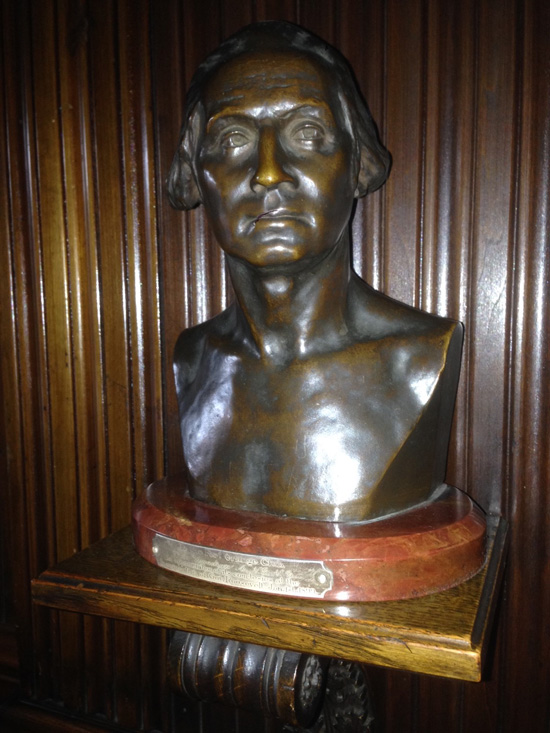
STATUE OF GEORGE WASHINGTON
In 1784, the Virginia General Assembly commissioned a statue of George Washington "to be of the finest marble and the best workmanship," necessitating a European craftsman. The Governor of Virginia gave the responsibility of selecting the artist to Thomas Jefferson, then ambassador to France, who together with Benjamin Franklin recommended that Jean-Antoine Houdon, the most famous sculptor of the day, execute the work.
Unsatisfied to work from a drawing of Washington by Charles Willson Pealesent for the project, and lured by a potential commission for an equestrian monument by the Congress of the Confederation, Houdon agreed to travel to the United States to work directly from Washington. His voyage was conditional on his life being insured for the trip, asking "that ten thousand livres be paid to his family should he die during the voyage. In July 1785, Houdon sailed with Benjamin Franklin and "two of his workmen” from Southampton, England, arriving in Philadelphia, Pennsylvania in September.
In early October 1785, Houdon along with three assistants stayed at Washington's plantation, Mount Vernon, taking detailed measurements of Washington's arms, legs, hands and chest and making a life mask of his face. By December, Houdon had returned to France.
Though inscribed with the date "1788", it was completed in France in 1791 or 1792 (depending on the source.) It was finally delivered to Richmond in 1796 and placed in the rotunda on May 14, 1796. Various explanations for the delay in its delivery have been given, including the French Revolution and untimely payments to Houdon, though most sources agree that the continued construction of the new Virginia State Capitol prevented its installation until the time it arrived.
In the early 21st century, the statue, together with the life mask and bust created by Houdon during the design process, were used as part of a forensic reconstruction of George Washington at various ages undertaken by the custodians of Mount Vernon.
Chief Justice John Marshall, a contemporary of Washington's said of the work, "Nothing in bronze or stone could be a more perfect image than this statue of the living Washington.”
Beginning in the 19th century, numerous copies of the statue have been made in bronze and plaster, with molds often made directly from the original. The Fort Orange Club currently owns one of those exact copies.
This sits on a shelf in the back right corner of the Library.
ALBANY CITY HALL LAMPPOSTS
Acquired in 1881 from the City of Albany
Still in place today, these lampposts are a distinctive addition to the Washington Avenue entrance to the Club. Resting on a base of crouching griffins, which are associated with Minerva, the Roman goddess of the city, the lamps once graced the entrance of Albany City Hall on Eagle Street, surviving the fire that consumed the building in February 1880.
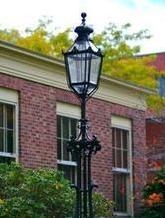
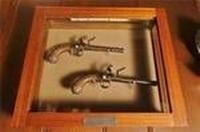
THE BARON STEUBEN PISTOLS
Presented to the Club in 1891
Mrs. George Evans presented the pistols in memory of her late husband who was one of the Club’s Charter members. The Club made headlines when the dueling pistols were stolen from its collection in 1956 by a former bellboy who traded them for modern handguns that he and an accomplice used to rob a State Street liquor store. The sale of the antique handguns provided the clues to solving the holdup. Eventually the firearms were returned to the Club and are displayed in the Tap Room.
EDWARD P. BUYCK MURALS
Commissioned by the Fort Orange Club in 1937
Edward P. Buyck, an Albany-area painter trained in Europe, created five murals for the newly remodeled Tap Room. They depict historic scenes of Albany and include the Half Moon, Fort Orange, the Intersection of State and Pearl Streets, View of Albany from the East Bank of the Hudson, and the Cohoes Falls. The murals were later restored in 1993 by Caroline Keck, a leading conservator from Cooperstown, NY.
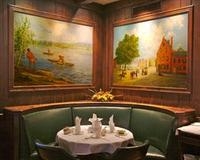
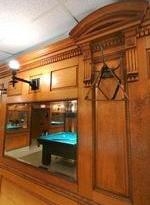
KEELER RESTAURANT’S OAK AND BEVELED-GLASS PANELING
Obtained in 1970 by Club Officers
Keeler's Restaurant, the city's oldest and most distinguished eating establishment closed in 1969 after more that a century in downtown Albany. The purchase of the paneling by the Club was heralded as a "brilliant acquisition of a piece of old Albany which will be cherished..."
Most of the paneling was used to line the walls of the new Billiard Room and the surplus served as the perfect backdrop to the Club's back entranceway, creating a handsome and nostalgic atmosphere in which to welcome Club members and guests.
SADLER PRINTS
Presented in 1969
Gaynor Keeler presented the prints to the Albany Institute of History and Art with a proviso that they be placed on indefinite loan to the Fort Orange Club. An exceptional collection of more than 100 prints by W. Dendy Sadler, a well-known English artist who specialized in scenes of everyday life, originally decorated the walls of the famous Keeler Restaurant in downtown Albany. Presented by Keeler in memory of his father, they are proudly displayed throughout the many rooms of the Clubhouse.
